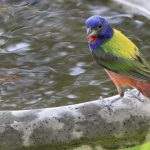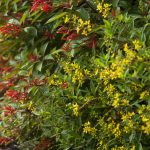Wildlife Gardens
Invite birds, bees and other beneficial wildlife to share your little corner of Texas.

Wildscaping
A wildscape simply means that your landscape benefits wildlife. As more and more wildlife habitat is converted into suburbs and shopping malls, there is an increased need to create the conditions necessary to support wildlife.
Today many homeowners building at the edge of the city are leaving a portion of their property in a natural state while enhancing other areas of their landscape with an eye towards attracting the birds and butterflies they enjoy. If you don’t have a built-in natural area, wildscapes are easy to create and very low maintenance.
Wildscape Elements
Food
Plant a variety of nectar, seed and berry producing plants to provide a variety of food sources throughout the year.
Water
Provide a clean source of water such as a birdbath or small pond.
Cover
Choose plant in a variety of heights. Think about creating a “wall” of foliage. Low, dry stacked walls are attractive and good cover for the wee ones too.
A Place to Raise Young
Keep dead limbs or snags if they don’t pose a threat to your property so wildlife has a place to hide and raise their young.
DESIGNS
BASIC MAINTENANCE
- Keep water source clean
- Prune shrubs as needed, usually in late winter
- Let seed set on reseeding annuals such as wildflowers before removing
- Keep edges of the landscape neat when adjacent to a neighbors’ more traditional yard.
IRRIGATION REQUIREMENTS
Native plants and adapted plants that benefit wildlife thrive in the local climate and soil conditions. Little additional irrigation is needed.
ADDITIONAL TIPS
Don’t use pesticides. A wide variety of plants helps bring protection against pests. “Good” bugs that are attracted to your landscape should easily control the “bad” bugs that are there.




